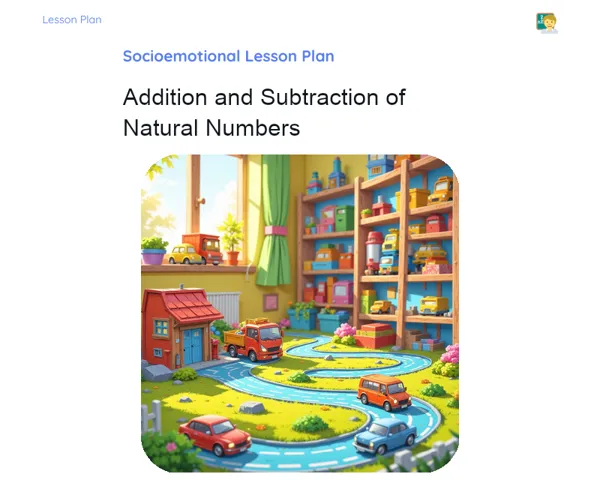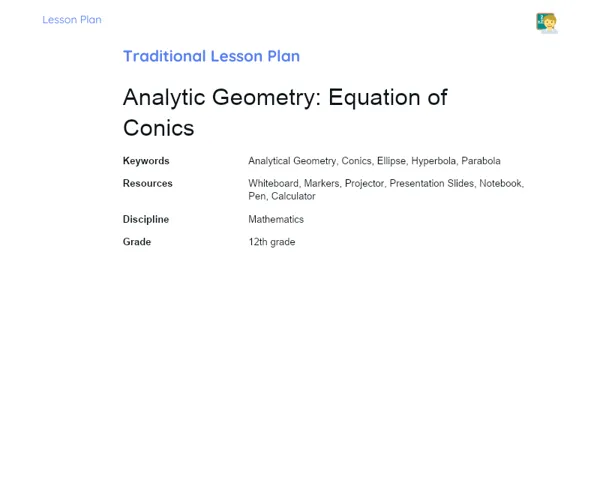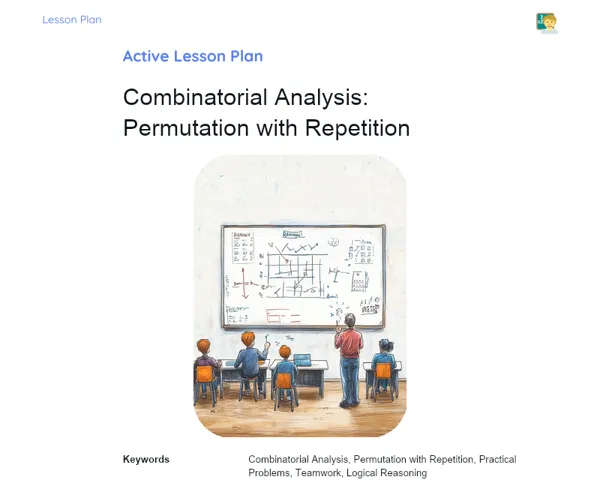Lesson Plan | Lesson Plan Tradisional | Spatial Geometry: Surface Area of the Cone
| Keywords | Spatial Geometry, Volume of the Cone, Formula V = (1/3)πr²h, Base Area of the Cone, Area of the Circle, Practical Examples, Problem Solving, Context and Curiosity, Student Engagement, Discussion and Reflection |
| Resources | Whiteboard and markers, Three-dimensional model of a cone, Calculators, Notebooks and pens for note-taking, Exercise sheets, Projector (optional) |
Objectives
Duration: 10 - 15 minutes
The purpose of this section is to provide students with a clear overview of the learning objectives for the lesson. By outlining the main goals, the teacher can effectively focus on imparting specific knowledge, ensuring that students grasp the fundamental concepts necessary for calculating the volumes of cones. This step helps set clear expectations and learning outcomes for the students.
Objectives Utama:
1. Understand the formula for the volume of a cone, which is calculated as one-third the area of the base multiplied by the height.
2. Identify and compute the area of the base of a cone using the formula for the area of a circle.
3. Apply the volume formula for a cone in real-life examples and mathematical problems.
Introduction
Duration: 10 - 15 minutes
🎯 Purpose: This segment aims to engage students by connecting them to the topic at hand, piquing their interest and curiosity. By providing an initial context and interesting facts about cones, the teacher bridges the gap between theoretical content and its practical applications in real life. This foundational stage sets the tone for effective information absorption and student engagement.
Did you know?
🔍 Curiosity: Cones are geometric shapes we routinely encounter in our daily lives. Think of traffic cones that help manage road safety or ice cream cones that we enjoy on a hot summer day. Knowing how to calculate the volume can be quite useful in various fields like engineering and architecture, where accurate space and volume calculations are crucial.
Contextualization
🛠️ Context: Begin the class by providing an overview of the topics that will be covered. Explain that today's focus will be on Spatial Geometry, particularly on calculating the volume of a cone. Use a three-dimensional cone model to illustrate the concept. Draw a cone on the board and mark its key parts: the base, height, and slant height. This approach will enhance students' visualization of the subject matter and clarify the significance of each measurement in the volume formula.
Concepts
Duration: 60 - 65 minutes
🎯 Purpose: This segment aims to enhance students' understanding of how to calculate the volume of a cone, blending both practical and theoretical insight. By tackling specific topics and collaboratively solving problems, students develop critical skills in applying the volume formula for cones across different mathematical scenarios. This guided practice solidifies learning and highlights areas where further reinforcement may be needed.
Relevant Topics
1. 📐 Formula for the Volume of a Cone: Explain the formula V = (1/3)πr²h, where V denotes the volume, r is the radius of the base, and h represents the height of the cone. Elaborate on how this formula is derived from the integration of the volume of a cylinder while relating the areas of the bases and heights.
2. 📏 Identification and Calculation of the Base Area: Revise the formula for the area of a circle, A = πr², and illustrate how to apply it to find the base area of the cone. Use relatable examples to clarify the calculations.
3. 📝 Practical Examples: Utilize real-life scenarios to apply the volume formula. Solve problems on the board step by step, emphasizing each phase of the calculation. Encourage students to write down these detailed steps in their notebooks.
4. 🔄 Guided Problem Solving: Present additional problems and work through them with the class. Promote student participation by inviting questions and verifying answers together. Provide immediate feedback to support comprehension.
To Reinforce Learning
1. Calculate the volume of a cone with a radius of 3 cm and a height of 9 cm.
2. A cone has a volume of 150 cm³ and a height of 10 cm. What is the radius of the base?
3. If the area of the base of a cone is 25π cm² and its height is 12 cm, what is the volume of the cone?
Feedback
Duration: 15 - 20 minutes
🎯 Purpose: This phase consolidates learning by encouraging students to discuss and review their answers. Engaging in detailed discussions fosters a deeper grasp of concepts and problem-solving techniques, while student interaction through questions and reflections nurtures active participation and critical thinking.
Diskusi Concepts
1. Calculate the volume of a cone with a radius of 3 cm and a height of 9 cm: Step 1: List the given values: radius (r) = 3 cm and height (h) = 9 cm. Step 2: Apply the volume formula for the cone: V = (1/3)πr²h. Step 3: Substitute the values into the formula: V = (1/3)π(3)²(9). Step 4: Calculate: V = (1/3)π(9)(9) = (1/3)π(81) = 27π cm³. Answer: The volume of the cone is 27π cm³.
2. A cone has a volume of 150 cm³ and a height of 10 cm. What is the radius of the base? Step 1: Identify the given values: volume (V) = 150 cm³ and height (h) = 10 cm. Step 2: Apply the volume formula for the cone: V = (1/3)πr²h. Step 3: Substitute values into the formula and solve for r: 150 = (1/3)πr²(10). Step 4: Simplify the equation: 150 = (10/3)πr². Step 5: Isolate r²: r² = (150 * 3) / (10π) = 45/π. Step 6: Calculate r: r = √(45/π) ≈ 3.79 cm. Answer: The radius of the base is approximately 3.79 cm.
3. If the area of the base of a cone is 25π cm² and its height is 12 cm, what is the volume of the cone? Step 1: Identify the given values: area of the base (A) = 25π cm² and height (h) = 12 cm. Step 2: Use the area formula to determine the radius: A = πr², hence 25π = πr². Step 3: Simplify to find r²: r² = 25. Step 4: Calculate r: r = √25 = 5 cm. Step 5: Apply the volume formula for the cone: V = (1/3)πr²h. Step 6: Substitute the values into the formula: V = (1/3)π(5)²(12). Step 7: Calculate: V = (1/3)π(25)(12) = 100π cm³. Answer: The volume of the cone is 100π cm³.
Engaging Students
1. 🔍 Question 1: What challenges did you face while solving the problems presented? 2. 🔍 Question 2: How would you verify if your answer is correct? 3. 🔍 Question 3: Can you provide a real-life scenario where calculating the volume of a cone would be essential? 4. 🔍 Reflection: Why is understanding the relationship between the base area and height vital for calculating the volume of a cone?
Conclusion
Duration: 10 - 15 minutes
The purpose of this section is to review and consolidate the knowledge acquired during the lesson. By summarizing essential points, the teacher aids students in retaining key concepts. The synergy between theory and practice reinforces the content's applicability, while discussing the topic's relevance encourages students to appreciate their learning. This stage concludes the lesson in a structured and reflective manner, ensuring that students leave with a solid and practical understanding of the volume of a cone.
Summary
['The formula for the volume of a cone is V = (1/3)πr²h, where V stands for the volume, r is the base radius, and h is the height of the cone.', "The base area of a cone can be calculated using the circle's area formula A = πr².", 'The practical uses of the volume formula for a cone have been demonstrated through examples.', 'Students practiced solving problems with guidance from the teacher, reinforcing the knowledge gained.']
Connection
The lesson tied theory to practice by thoroughly explaining the mathematical formulas involved in calculating the volume of a cone and demonstrating how these formulas can be applied in real-world scenarios. Collaborative problem-solving allows students to see the relevance of formulas in practice, enhancing their understanding of theoretical concepts.
Theme Relevance
Understanding how to calculate the volume of a cone is essential in diverse daily situations and professions. For instance, in fields like engineering and architecture, accurate volume calculations are pivotal for construction projects. Additionally, cones are common shapes found in everyday items, such as traffic cones and ice cream cones. Mastery of these mathematical computations helps us comprehend our surroundings better and make informed decisions in both professional and personal realms.



